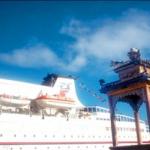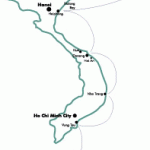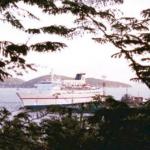Cruising Vietnam
* * *
A two week vacation in exotic locations with all the comforts of home and none of the hassles of traveling. No way? We found a way. We spent two weeks in Asia, including 10 days in Vietnam, visited a wide range of cities - Hong Kong, Halong Bay, Haiphong, Danang, Hanoi, Hue, Hoi An, Nha Trang, Ho Chi Minh City and Singapore - and all the while enjoyed good food, hot showers and starched sheets. And, of course, breakfast in our cabin every morning!
We recently cruised down the Vietnam coast aboard the Ocean Pearl. In 1994 the Pearl made the trip eight times. We were on the seventh passage, so things ran smoothly. The Pearl is a 517 foot, 12,000 ton ocean going cruise ship with a capacity of 500 passengers. It was my first cruise, but for my partner Lisa Spivey, an experienced sailor of China's Yangtze River, this mode of transportation was second nature.
We flew to Hong Kong and boarded the Pearl the day before she was due to sail. The Hong Kong Ocean Terminal, where the ship docks, is only 15 minutes from the Hong Kong International Airport. We opted for a short layover, but many travelers arrange to arrive in Hong Kong several days early to do some sightseeing and shopping.
Departing Hong Kong in the early evening we were treated to a fascinating show of life on the harbor while we enjoyed our first meal in the ship's dining room (early seating is at 7:00pm, late seating at 9:00pm). You can eat 24 hours a day on the ship, whether in the main dining room, one of the many lounges, or by calling room service.
The next day was spent sailing the South China Sea. We wandered around the ship, getting to know our floating hotel. The nine decks feature such amenities as a movie theater, discotheque, bar, dinning room, barbecue deck, beauty salon, gift shop, medical clinic and two swimming pools (indoor and outdoor). There is also a photo lab on board (yes, the pictures you take during the day can be shown to your dining companions at dinner), laundry and dry cleaning service, and a radio room where you can send and receive faxes (there is no getting away from the office). International phone calls can be made and received in your cabin.
Joanne, our tour manager, gave a two hour port briefing in the lounge, covering shore excursions and what to expect when we got to Vietnam. One of the advantages of traveling this way is you have the flexibility of taking a group tour, staying on board, or traveling independently. There was always an organized activity to keep you busy on the ship, from lectures to exercise classes to cooking demonstrations, or you could just catch up on your reading.
Throughout the trip we took the opportunity to meet and chat with fellow travelers. There was a professional tour leader from Hawaii who was constantly on the go while her husband enjoyed spending his vacation on the sun deck and the beaches. A Vietnamese-American from the Midwest was on his first trip home in 20 years. A well traveled lawyer from San Francisco taught us a lot about the region's geology. A French-American woman told us about her travels to Angkor Wat over 40 years ago.
At sunrise we arrived in Halong Bay with its islands rising from the clear blue-green waters of the Gulf of Tonkin. The 30 minutes or so it took from the moment we sighted the first of the limestone islands to the time we dropped anchor was worth the whole trip. It was like waking up in the middle of the movie Indochine, except seeing the bay all around you is completely different from a two-dimensional picture.
Nothing we could show you in print can do it justice. The height of the ship (six decks above water) afforded us a view which going around the bay in a small boat does not.Halong, which means "where the dragon descends into the sea", got its name from the legend of the great dragon who lived in the mountains. As the dragon plunged into the sea, his thrashing tail created this magnificent bay with its 3,000 islands, beaches and grottoes.
After we dropped anchor and the staff cleared customs and immigration for us, a small boat took us ashore to the Hong Gai port. Buses were already waiting for the ride to Haiphong.Since we wanted to check out new hotels and developments in the area, we had arranged for a car to meet us at Hong Gai (the tour office on board ship can arrange such miracles).
The trip from Hong Gai to Haiphong involves two ferry crossings. Each crossing takes about half an hour, including the loading and unloading of trucks, buses, cars, motorcycles, bicycles and passengers. If there are no lines at the ferry, the whole trip takes two and a half hours. If traffic is heavy and you have to wait for a second or a third ferry, it could take more than four hours.
Most people we talked to enjoyed the process of getting there-it was a journey in itself. Long or short, the drive to Haiphong gave us the opportunity to observe everyday life in Vietnam. Riding the ferries we watched the small vans packed with consumer electronics, motorcycles laden with everything from chickens to crushed rocks, bicycles loaded with firewood, and children as curious about us as we were about them.
It was a full day and we got back to the ship at 6:30pm. The next day, small boats came alongside the ship to take passengers for two-hour rides around the bay to look more closely at some of the islands, beaches and caves.
The ease of moving from one city to the next was unbelievable. There was no mad dash for the airport and no packing and unpacking. As a leisurely lunch was served on the deck, we raised anchor and set out for Danang.
After a briefing about the next ports of call, people settled down in the reading room which had a small library and tables for card games or sat in the air-conditioned comfort of the observation deck and watched the sea. After dinner it was time to enjoy a drink in the piano lounge, catch one of the floor shows, dance in the nightclub, or have a quiet moment on the promenade deck under the stars.
We arrived in Danang mid-morning the next day and a school band greeted us at the dock. Well organized lines of buses were ready to take us to different destinations. Since we had three days there everyone was able to take in a variety of sites. One group went to the airport for a day trip to Hanoi.
Another went by bus to Hue, a three and a half hour trip. Yet another group headed for Hoi An, an hour's drive south of Danang. A shorter, half-day excursion was available to the Marble Mountains and China Beach. Some chose a more leisurely day, taking a cyclo ride around Danang to see the Cham museum, various temples, the local market and the small shops.
We decided to travel independently and hired a car to drive us to My Son. My Son is one of Vietnam's major Cham sites and has the potential of being a popular tourist destination as it becomes more accessible.
Set in a valley surrounded by green hills, some 20 structures remain, several dating back to the 8th century. It is a relatively rigorous trip: one hour by car on a paved road, half an hour on unpaved road, 10 minutes on the back of a motorcycle, a small ferry crossing, a five minute ride on another motorcycle, and a 10 minute walk down a small path. Was it worth it? Yes! We got to see a part of Vietnam's early history and be Indiana Jones for a day, knowing all the while that a hot shower was waiting for us back at the ship.
The next day we were off to Hoi An, an easy one hour drive from Danang. We had enjoyed it so much on previous trips that we wanted to spend more time exploring the old port town.
Hoi An, on the Thu Bon River near the South China Sea, is a step back in time. This 2,000 year old city was once the heart of the Champa kingdom. It later became an administrative center for the French and the location of the first Chinese settlement in Vietnam. From the 17th to the 19th centuries Hoi An was among the most active ports in Southeast Asia and its unique architecture still reflects the influence of the Japanese, Portuguese, Dutch, French and Chinese merchants who came here to buy silk, paper, porcelain, tea, sugar, lacquer, elephant tusks, and mother-of-pearl.
As the sun was setting we left for Nha Trang, a 19 hour sail down the coast from Danang. Sailing into Nha Trang around noon the next day again offered us a new perspective. We saw the beautiful untouched beaches and the Cau Da Villas atop the hill overlooking the bay.
Since the stop in Nha Trang was going to be short (half a day), almost everyone took the organized tour to the Long Son Pagoda, the Po Nagar Cham Tower, the Pasteur Institute, and finally the beach where we all drank juice from freshly cut coconuts. The more relaxed crowd took a bus ride down to the beach where they spent the whole afternoon.
"After a long day, it's great to come back to a hot shower, gourmet food and clean sheets," said Dennis, one of our shipmates, as our mini-bus reached the port. It was almost 7:00pm and as the bus rounded the last bend we could see the port and the Ocean Pearl, lit up against the evening sky. "Yes," I told myself, "you are right, Dennis, I can't wait to get in that hot shower." Lisa was happy she could get a chilled glass of wine.
We were getting the hang of cruising by now. The Pearl's crew were experts at making everyone feel at home. Ray, the cabin steward, always made sure our cabins were in perfect order. Our laundry and dry cleaning were well taken care of and on many occasions when we were too tired for the dining room Ray served us our dinner in the cabin. Willy on the promenade deck always showed up with Lisa's regular (iced tea) and knew exactly where we preferred to sit (port side, under an umbrella).
By 8:00 am the next morning we were already passing Vung Tau. The ship then proceeded up the Saigon River on the way to Ho Chi Minh City. For the next four hours we sailed slowly up the river which was bustling with activity. Small boats went up and down the small tributaries. Barges carried dirt, cement and construction material.
At noon, we pulled up alongside the Saigon port. We looked out at the downtown area and the Saigon Floating Hotel, a luxury property docked along the river. On the opposite shore, billboards advertised beer, televisions, Compaq computers and Xerox machines.
The welcome committee set off a long string of firecrackers as we docked. To one side, 10 big tour buses and many more smaller vans were parked in a row, waiting to whisk us off in different directions: My Tho on the Mekong Delta, a Saigon city tour, Cholon , or the outskirts of Ho Chi Minh City. From Ho Chi Minh City one could also drive two hours to Vung Tau, a popular seaside resort. Some people took a cyclo ride to the shopping area around Dong Khoi Street, the Ben Thanh market or the Lam Son lacquer factory.
All too soon, it was time to sail to Singapore. It was fascinating ending the cruise in Singapore, a city located at the convergence of sea routes that has witnessed many Indochina travelers over the years. When Sir Stamford Raffles established a settlement in Singapore in 1819 he declared it was perfectly situated to become a great trading post. Indeed, it is now one of the busiest ports in the world, and a city we are liking more with every visit.
* * * * *
 ThingsAsian
ThingsAsian



















